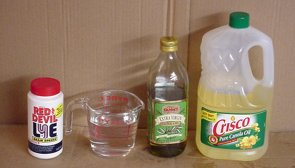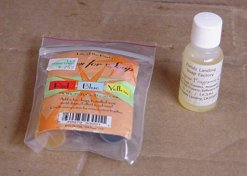|
|
About the Ingredients
Oil or Fats - Almost any natural
oil or animal fat can be turned into soap. Some examples are corn oil,
canola oil, olive oil, vegetable shortening, tallow, bacon grease, lard
etc.. (more information is provided about the different kinds of oils and
fat at the link below referencing Oil Properties.
Red Devil brand 100% lye (NaOH) sodium hydroxide - This is the ingredient that converts the oil or fat to soap. It used to be extracted from ashes in earlier times but now is widely available. Try home improvement, grocery or hardware stores. Usually comes in 12 oz. cans for aprox. $2.00/can. Their are other brands besides Red Devil that are just as good but not as commonly found.
Water - Preferably distilled water or bottled water. Minerals in hard tap water aren't good for soapmaking.


Soap Colorants - These can be purchase from a soap supply store or you can use crayons made from stearic acid (most are) If you use crayons melt a piece and add it at the trace stage.
What you will need
(almost everything you will need can be found at at Walmart and your local Grocery Store)
-Pair of safety goggles and a
long sleeve shirt or coveralls. (Important)
-Pair of Neoprene rubber gloves
or dish washing gloves.
-Half gallon Rubbermaid type
pitchers (dishwasher safe). One for water, one for lye.
-Sturdy plastic stirring spoons,
one for oils, one for lye/water mix.
-Glass (not aluminum) candy
thermometers.
-Large enameled or stainless
pot to melt oils in. (16 qt. would work). (Do not use aluminum pots, only
stainless steel or enameled.)
-Old blanket, preferably wool.
(For insulating molds after pouring)
-Kitchen food scale or postal
scale.
-Saran type food wrap. (For
lining molds)
-Molds
-Stick Blender is optional (creates
a faster trace)

For blender soap you will also need:
-Standard Kitchen Blender with
lid
-Towel


|
|
|
|
|
|
|
|
|
|
|
|
|
|
|
|
|
|
|
|
Third Party Advertising Google, one of our third-party advertisers, may add a cookie to determine targeted advertisements based on your preferences and your visit to our site and other sites on the internet. You can choose to opt out of Googles use of cookies by visiting the Google ad and content network privacy policy.